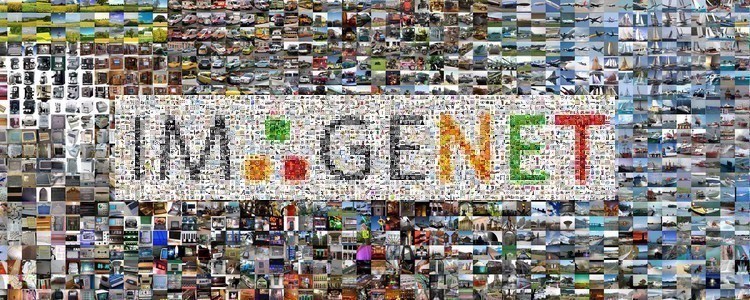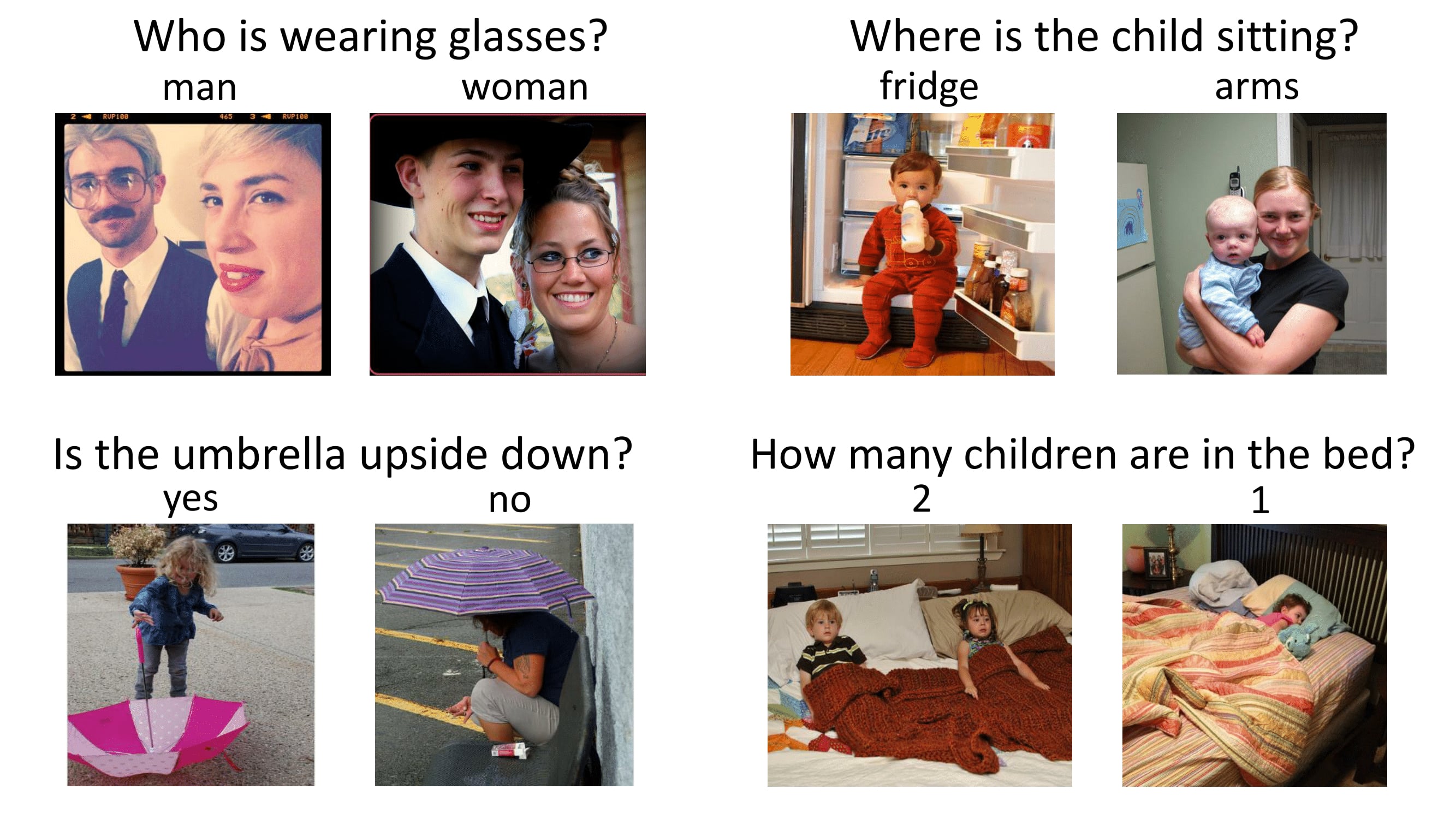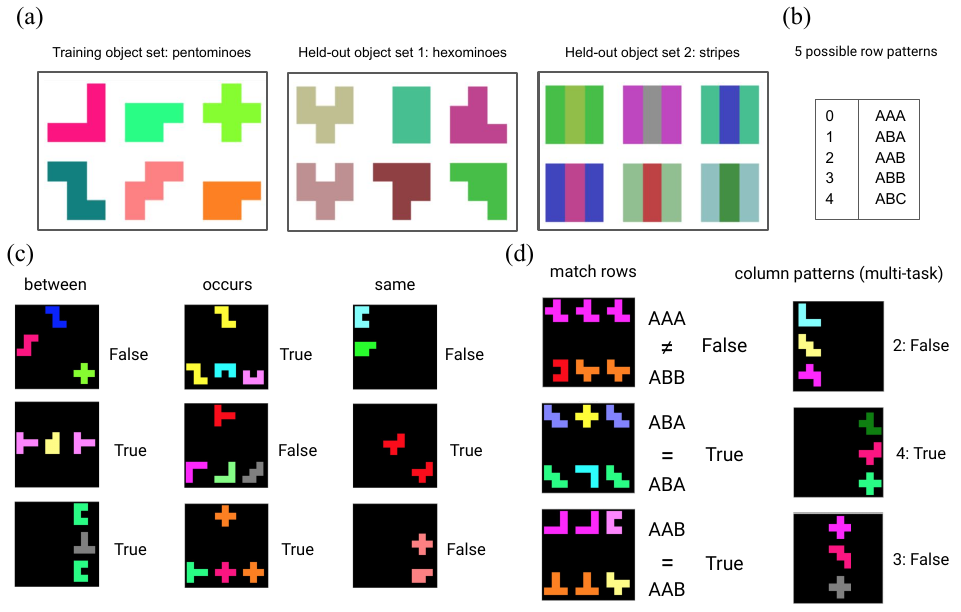Bridging machine learning and logical reasoning by
Abductive Learning
(Press ? for help, n and p for next and previous slide)
Department of Computing, Imperial College London
Joint work with Qiuling Xu$^\dagger$, Yang Yu$^\dagger$ and Zhi-Hua Zhou
Thursday Nov 28th, 2019Motivation
Machine Learning
... now is VERY good at
Machine Learning
... now is NOT very good at
Machine Learning
... now is almost INCAPABLE of
Question: Solve -42*r + 27*c = -1167 and 130*r + 4*c = 372 for r.
Answer: 4
Question: Calculate -841880142.544 + 411127.
Answer: -841469015.544
Question: Let x(g) = 9*g + 1. Let q(c) = 2*c + 1. Let f(i) = 3*i - 39. Let w(j) = q(x(j)). Calculate f(w(a)).
Answer: 54*a - 30
Question: Let e(l) = l - 6. Is 2 a factor of both e(9) and 2?
Answer: False
Question: Let u(n) = -n**3 - n**2. Let e(c) = -2*c**3 + c. Let l(j) = -118*e(j) + 54*u(j). What is the derivative of l(a)?
Answer: 546*a**2 - 108*a - 118
Question: Three letters picked without replacement from qqqkkklkqkkk. Give prob of sequence qql.
Answer: 1/110
A Modern Rephrase of Curve Fitting

Combine Learning and Relational Reasoning
- Inductive Logic Programming
- Statistical Relational Learning
- Probabilistic Logic Programming
- Probabilistic Programming
- Fuzzy Logic
- …
- Neural Symbolic Learning
- Memory-based neural nets
- Attention-based neural nets
- Neural program synthesis
- …
Hybrid Model
Recent Advances
- Neural Module Networks (Andreas, et al., 2016)
- Logic Tensor Network (Serafini and Garcez, 2016)
- Neural Theorem Prover (Rocktäschel and Riedel, 2017)
- Differential ILP (Evans and Grefenstette, 2018)
- DeepProblog (Manhaeve et al., 2018)
- Symbol extraction via RL (Penkov and Ramamoorthy, 2019)
- Predicate Network (Shanahan et al., 2019)
Remaining Questions
- Do we really need to relax logical calculi with continuous functions?
- Now we have gradients, which is good, but we also lose many other things:
- Distributed representations vs extrapolation;
- Probabilistic and fuzzy operators bring independent assumptions;
- High speed inference requires pre-compiled network structures, difficult to learn first-order logical theories;
- Now we have gradients, which is good, but we also lose many other things:
- Do we really need huge amount of labelled data?
- What about heavy-reasoning tasks?
- How do we (humans) solve these problems?
A Human Example
The Mayan Calendars
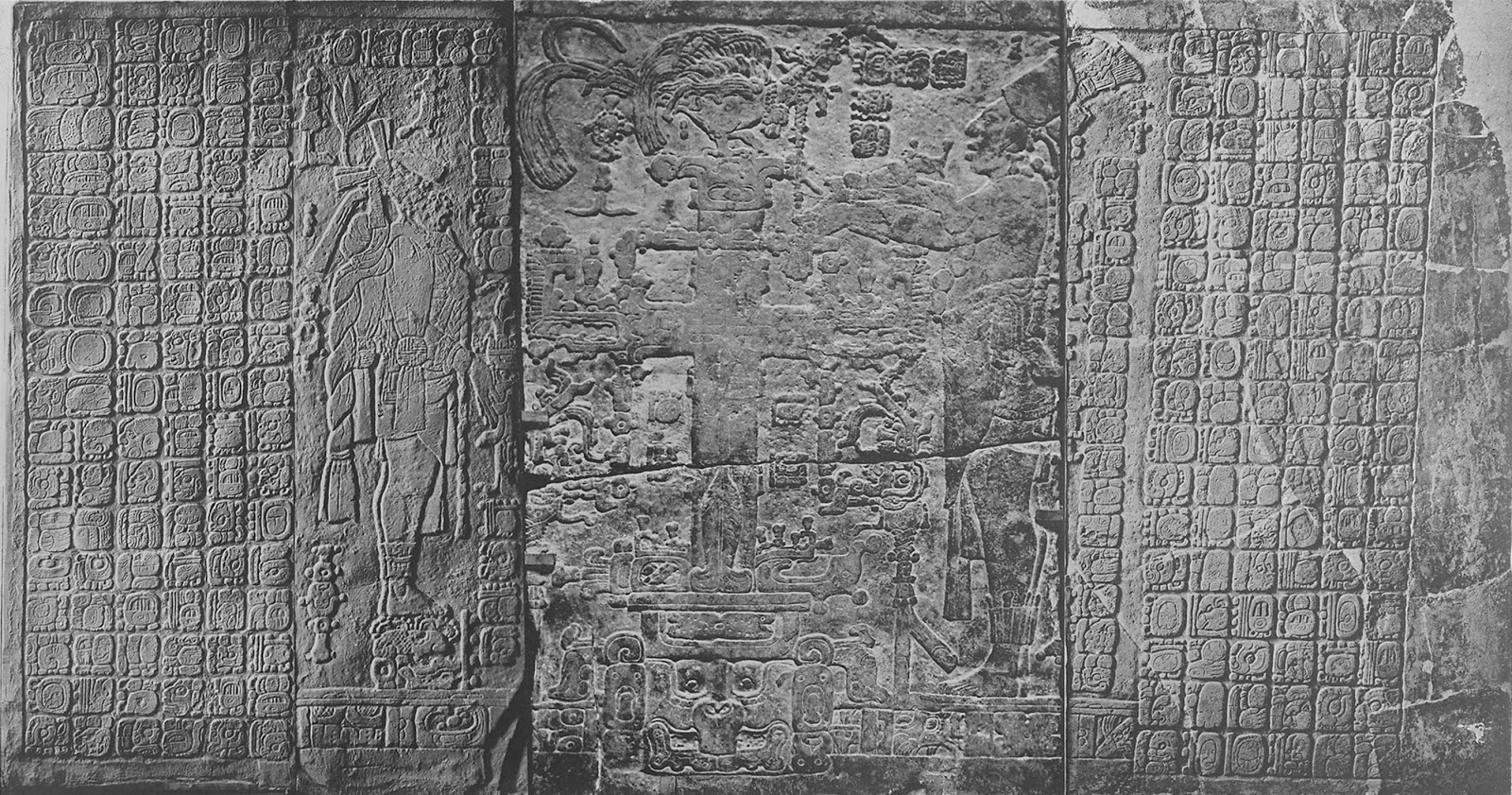
It records some big events and their dates.
The calendar
- Row 1-2: \(X\) (Creation)
- Row 3-7: \(Y\) (Long-count)
- Row 8-9: \(Z\) (Tzolkin & Haab)
Calculation \[ X\oplus Y=Z \]

The “head variants”
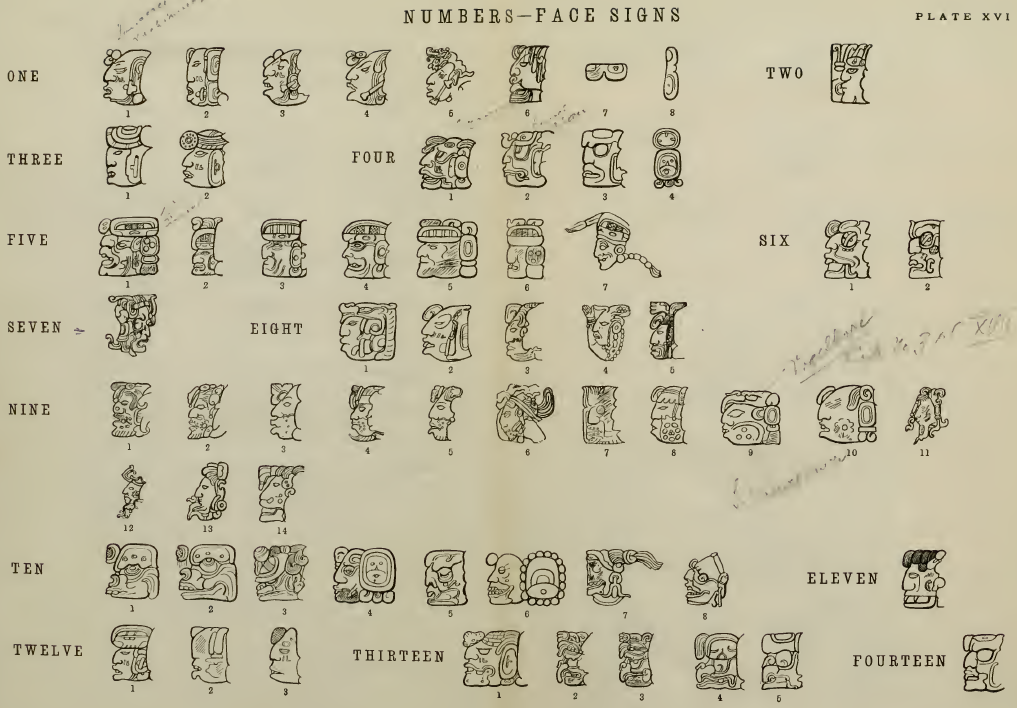
Cracking the glyphs
Cracking the glyphs
- Perception:
- \(\text{Glyphs}\) (image) \(\mapsto\) \(\text{Numbers}\) (symbol);
- Abduction:
- Observation: the equations on tablet must be correct;
- Background Knowledge:
- Calendar structure: \(X\oplus Y=Z\)
- Calculation rules: 20-based \(\oplus\);
- Explanation: possible digits on the tablet that are consistent with background knowledge and observation
- Trial-and-errors:
- Make abductions until the perception and reasoning are consistent.
Abductive Learning
The Framework

- Machine learning:
- Perception model \(p\) mapping raw data ⟶ primitive logic facts;
- Logical abduction:
- Abduces pseudo label (primitive logic facts facts) to re-train \(p\);
- Learns logical rules \(\Delta_C\) to complete the reasoning from primitive logic facts ⟶ final concept;
- Optimise the consistency of hypothesis and data.
Formulation
Intuition:
- Maximise the consistency between training data \(D\) and hypothesis \(H\):
where \(\text{Con}(H\cup D)\) is the size of subset in training data that is consistent with \(H\):
Optimisation
- Optimise the function guessing about the wrongly perceived symbols.
- Abduce consistent assignments for the wrongly perceived ones.
Compare to conventional supervised Learning
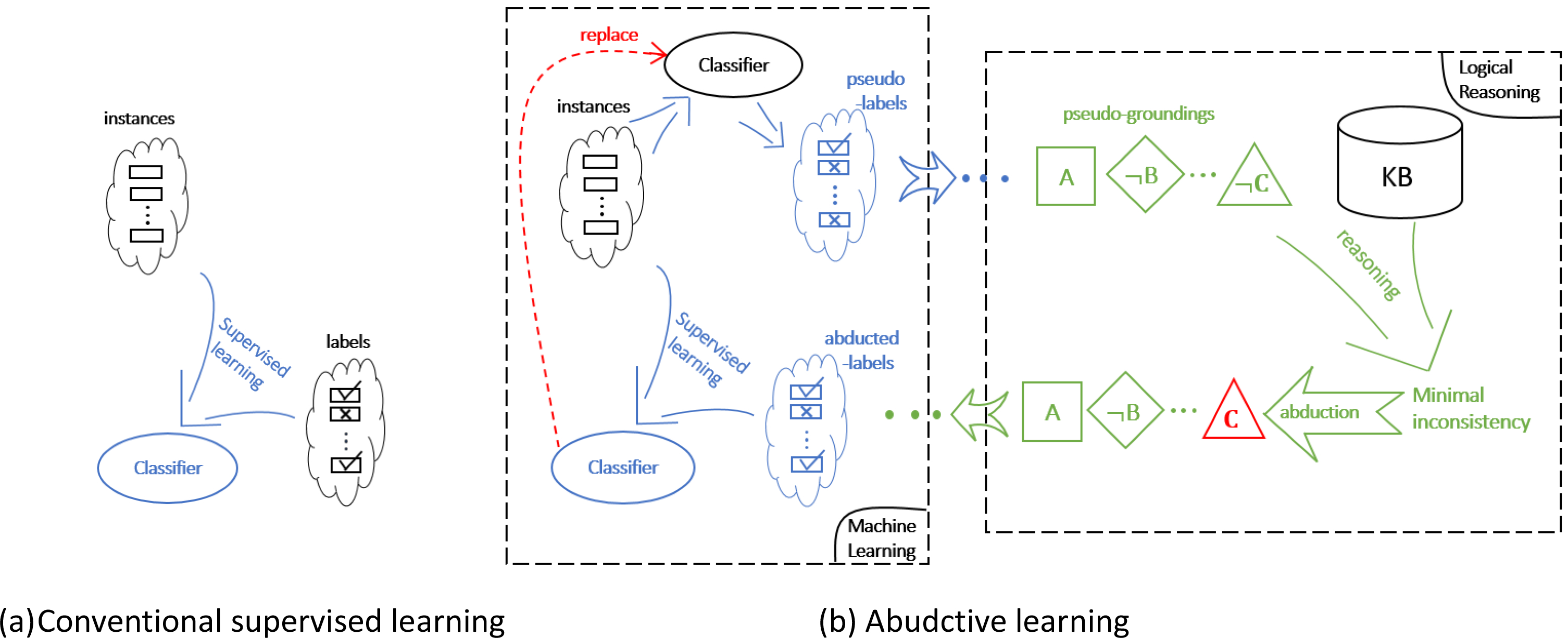
Experiments
Handwritten Equation Decipherment
- Input: Image sequence only with label of equation’s correctness
- Output:
- Well-trained CNN \(p:\mathbb{R}^d\mapsto\{0,1,+,=\}\)
- Operation rules:
- e.g.
1+1=10,1+0=1,…(add);1+1=0,0+1=1,…(xor).
- e.g.
Setting
- Data: length 5-26 equations, each length 300 instances
- DBA: MNIST equations;
- RBA: Omniglot equations;
- Binary addition and exclusive-or.
- Compared methods:
- ABL-all: Our approach with all training data
- ABL-short: Our approach with only length 7-10 equations;
- DNC: Memory-based DNN;
- Transformer: Attention-based DNN;
- BiLSTM: Seq-2-seq baseline;
Background knowledge 1
Equation structure (DCG grammars):

- All equations are
X+Y=Z; - Digits are lists of
0and1.
Background knowledge 2
Binary operation:

- Calculated bit-by-bit, from the last to the first;
- Allow carries.
Implementation

- Perception model: Convolutional Neural Network
- Abductive reasoning model: Abductive Logic Programming
- Consistency optimisation: Derivative-Free Optimisation (RACOS)
Results
Test Acc. vs Eq. length
Training Log
%%%%%%%%%%%%%% LENGTH: 7 to 8 %%%%%%%%%%%%%%
This is the CNN's current label:
[[1, 2, 0, 1, 0, 1, 2, 0], [1, 1, 0, 1, 0, 1, 3, 3], [1, 1, 0, 1, 0, 1, 0, 3], [2, 0, 2, 1, 0, 1, 2], [1, 1, 0, 0, 0, 1, 2], [1, 0, 1, 1, 0, 1, 3, 0], [1, 1, 0, 3, 0, 1, 1], [0, 0, 2, 1, 0, 1, 1], [1, 3, 0, 1, 0, 1, 1], [1, 0, 1, 1, 0, 1, 3, 3]]
****Consistent instance:
consistent examples: [6, 8, 9]
mapping: {0: '+', 1: 0, 2: '=', 3: 1}
Current model's output:
00+1+00 01+0+00 0+00+011
Abduced labels:
00+1=00 01+0=00 0+00=011
Consistent percentage: 0.3
****Learned Rules:
rules: ['my_op([0],[0],[0,1])', 'my_op([1],[0],[0])', 'my_op([0],[1],[0])']
Train pool size is : 22
Training Log
...
This is the CNN's current label:
[[1, 1, 0, 1, 2, 1, 3, 3], [1, 3, 0, 3, 2, 1, 3], [1, 0, 1, 1, 2, 1, 3, 3], [1, 1, 0, 1, 0, 1, 3, 3], [1, 0, 1, 1, 2, 1, 3, 3], [1, 1, 0, 1, 0, 1, 3, 3], [1, 0, 3, 3, 2, 1, 1], [1, 1, 0, 1, 2, 1, 3, 3], [1, 1, 0, 1, 2, 1, 3, 3], [3, 0, 1, 1, 2, 1, 1]]
****Consistent instance:
consistent examples: [0, 1, 2, 3, 4, 5, 6, 7, 8, 9]
mapping: {0: '+', 1: 0, 2: '=', 3: 1}
Current model's output:
00+0=011 01+1=01 0+00=011 00+0=011 0+00=011 00+0=011 0+01=00 00+0=011 00+0=011 1+00=00
Abduced labels:
00+0=011 01+1=01 0+00=011 00+0=011 0+00=011 00+0=011 0+01=00 00+0=011 00+0=011 1+00=00
Consistent percentage: 1.0
****Learned feature:
rules: ['my_op([1],[0],[0])', 'my_op([0],[1],[0])', 'my_op([1],[1],[1])', 'my_op([0],[0],[0,1])']
Train pool size is : 77
Mutual Beneficial Perception & Reasoning
Training Acc.
Model Reuse
Reusing $p$ (L) vs reusing $\Delta_C$ (R)
Other classical AI techniques?
| ABL-ALP | ABL-CLP(FD) | ABL-CHR |
|---|---|---|
| 97.6% | 98.1% | 97.9% |
Deep Neural Net Only
| CNN | Bi-LSTM |
|---|---|
| 73.5% | 51.3% |
Conclusions
Conclusions
- Full-featured first-order logic:
- Handles heavy-reasoning problems & has better generalisation
- Requires much less labelled data on each instance of symbols;
- Flexible framework with switchable parts:
- Possible to plug in many symbolic AI approaches;
- Symbol invention instead of defining every primitive symbols before training;
- Improve the efficiency of the trial-and-errors, because abduction in general is neither sound or complete.
Each Play to Their Strengths
: http://daiwz.net
: https://github.com/AbductiveLearning/ABL-HED
